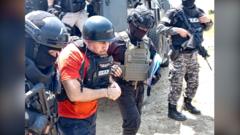Peru is currently experiencing an alarming rise in gang-related violence, characterized by extortion and brutal retaliations affecting businesses and communities.
Gang Violence in Peru: A Nation Living in Fear

Gang Violence in Peru: A Nation Living in Fear
As extortions rise, citizens face increasing intimidation from gangs throughout urban areas.
In recent months, the streets of Lima have witnessed a worrying pattern of violence that has left community members in a state of constant anxiety. Jorge Tejada, a 50-year-old recycling business owner, found his bus set ablaze overnight, a clear signal of gang retaliation for refusing to comply with extortion demands. “How many times can violence strike before we’re too scared to run our businesses?” he pondered, illustrating the growing fear among local entrepreneurs.
This escalation of crime contrasts starkly with the peaceful living conditions that famously characterized the area. Once a shantytown thriving through collective efforts, this capital district, like many others across Peru, has transformed into a battleground for gangs seeking to exert influence over shaky small businesses. Tejada recounted numerous incidents in his neighborhood, including violence at local bodegas and restaurants that experienced gunfire after resisting gang demands.
According to national police reports, extortion cases have seen a terrifying increase, skyrocketing from several hundred cases annually to over 2,000 monthly in just a few years. This epidemic has contributed to the alarming rise in contract killings throughout Peru, with many community members living in a constant state of dread.
As violence unfolds with grim frequency, the question of safety looms large over daily life for many Peruvians. “Now we all live in fear here,” Tejada reflects, summing up the sentiments that resonate through neighborhoods once regarded as safe and lively. The specter of gang violence has become all too familiar, and communities are left grappling with the devastation wrought by this swift and brutal escalation.
This escalation of crime contrasts starkly with the peaceful living conditions that famously characterized the area. Once a shantytown thriving through collective efforts, this capital district, like many others across Peru, has transformed into a battleground for gangs seeking to exert influence over shaky small businesses. Tejada recounted numerous incidents in his neighborhood, including violence at local bodegas and restaurants that experienced gunfire after resisting gang demands.
According to national police reports, extortion cases have seen a terrifying increase, skyrocketing from several hundred cases annually to over 2,000 monthly in just a few years. This epidemic has contributed to the alarming rise in contract killings throughout Peru, with many community members living in a constant state of dread.
As violence unfolds with grim frequency, the question of safety looms large over daily life for many Peruvians. “Now we all live in fear here,” Tejada reflects, summing up the sentiments that resonate through neighborhoods once regarded as safe and lively. The specter of gang violence has become all too familiar, and communities are left grappling with the devastation wrought by this swift and brutal escalation.

















